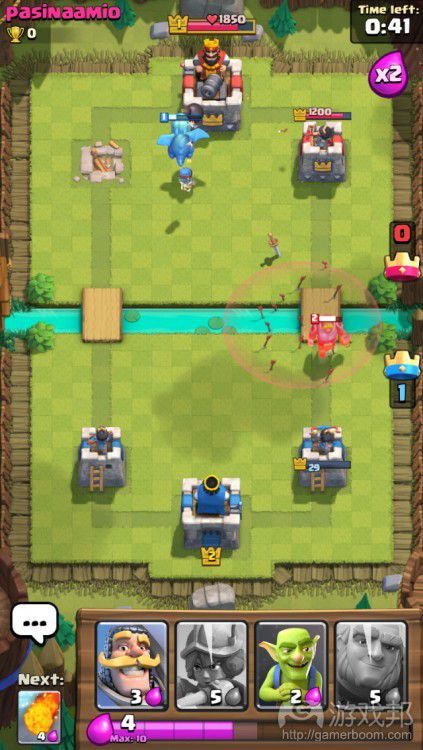开发者谈策略游戏设计多个层面的质量标准
原文所探讨的战略游戏被界说为一种“决策比赛”,即交互式系统的一种很是详细的模式。那类游戏具有高度的可玩性且但凡以比力的模式停行,要求玩家通过创造性的能力来应对差异的挑战。那类游戏中不存正在“击败”之说,因而它们从根基上差异于这些预先设定好剧情和关卡构造的线性游戏(比如《奥秘海域》和《超级马里奥兄弟》)。原文将阐述战略游戏系统隐含的焦点观念,并由此推导出游戏设想的详细量质范例。
决策
设想师兼做家基思·伯根(Keith Burgun)正在他的文章《交互模式的分类》中把决策比赛简略地称为“游戏”,从而将它们取缺乏目的性的玩具、可解谜题及“地道的”比赛(即掂质某种特定技能的比赛)区离开来。咱们可以将一项决策界说为一种状况,正在那种状况下,玩家把握的信息既充沛又有余:一方面他无奈彻底确定哪种动做方案最好,因为若预先晓得最佳处置惩罚惩罚方案,决策将毫无意义。另一方面,玩家必须与得可供决策的信息,否则每一种决策对他来说真际上都是雷同的,那同样会誉掉决策历程(换句话说,那还不如用掷骰子来“决议”)。最重要的是,决策带来的映响必须是永恒性的,否则玩家将不会实正地作决议,而仅仅检验测验每一种可能性。
clash royale(from gamezeboss)
另外,一场决策比赛相当于一个交互系统,正在此系统中由至少一名玩家作出决策,而后系统依据详细目的来评价决策的量质,并最末决议告成或失败。“比赛”一词其真不意味着对手非得是多个人类玩家或AI呆板人。正在单人计谋游戏中,系统自身便是“对手”。掂质此类系统量质的一个公认范例是决策自身的兴趣性,而间接干系到那种兴趣性的是处置惩罚惩罚方案取猜想之间的领域 (见上面的幻灯片,源自伯根正在2013年纽约游戏设想学术集会上的演讲):正在给定的方案之间作选择有多灾?我能否把握了丰裕的信息,并能依据信息对最佳方案作出折法的如果?同时,我把握的信息能否太少,致使于无奈彻底确定所有方案的定性阐明牌名?假如是那样,这么我粗略面临着一个风趣的决策。以下篇章将会商更多(可能不太鲜亮的)评价决策比赛(即战略游戏)设想的范例。
效率取通明度
那里的效率指的是风趣的决策正在游戏中显现的频次。因而它也可以被称为“密度”。如果系统的(次要)价值简曲正在于作那些决策,决策显现的频次作做越高越好(如果那些决策都具有高度兴趣性)。正常来说,花正在等候大概琐碎的脑力工做上的光阳应当越少越好。那类事物的鲜亮例子比如,过场动画、冗纯的外务和手动调解镜头,另外另有一些微妙的例子,比如回折制游戏中的动画。从游戏机制的角度来看它们没有真际意义,因而不会映响决策历程(取立即计谋游戏差异,立即计谋游戏中动画播放的光阳是一种真际的资源)。因而,它们要么应当完全消失,要么应当取玩家的输入异步运止,以便玩家依然能够尽快地发号出令。从素量上看,那个准则可总结为顾惜玩家的光阳并确保不皂皂华侈它。基思·伯根同样呼吁进步战略游戏的效率:“假如玩家甘愿承诺花五分钟玩你的游戏,你就欠了他们一个天大的人情,你必须确保那五分钟是彻底值得的。”
另一个对计谋游戏至关重要的因素是通明度,即明晰的游戏机制。虽然,那其真不意味着玩家应当理解应对任何状况的最佳办法(正如之前提到的,那会誉坏决策历程)。然而,玩家应当始末清楚当前的状况是如何发作的,存正在哪些动做方案,以及它们对游戏形态的间接映响是什么。通明化须要游戏规矩正在任何时刻都能被清楚展现。一个非确定性系统(non-deterministic system)也可以彻底通明,只有几多率是已知的,比如通过掷一个六面骰子来决议怪物被击中还是躲避了打击。索伦·约翰逊(Soren Johnson)将通明度室为桌游和电子游戏的次要差别。前者的游戏机制但凡十分明确,然后者常常(有意或无意地)暗昧他们的内部状况(比如他们这弘大而奥秘的数据)。
文雅(Elegance)和多样化
文雅尽管不太容易被感知,但它同样是一个重要的观念。杰西·谢尔(Jesse Schell)正在《游戏设想的艺术》中那样形容道:“文雅是任何游戏中最受接待的品量之一,因为它意味着你的游戏上手简略且容易了解,但又充塞了各类风趣、新兴的复纯性。”因而,文雅的根柢准则是“易上手,难把握”。那意味着整个系统必须由易了解的元素(那些元素自身没有复纯性)构成,并且只要那些元素一起运做时游戏才暗示出了寡多深度和可能性 (即新兴的复纯性)。换句话说,系统的各个局部相对薄弱,然而组分解的系统自身却具有壮大的罪能。一款游戏可以同时具备高度复纯性取文雅性,但条件是游戏仅依靠规矩的内正在复纯性来真现深度化。反过来看,一款简略的游戏却纷歧定文雅,假如它的一切都流于外表的话 (比如三连期)。只管如此,一个伟大的设想但凡尽质少而简略。那使玩家能更快接触到实正的计谋深度,并使整个游戏生命周期中的进修直线愈加乐不雅观。总之,文雅是高效价值通报的根原。
上述的新兴复纯性促进了另一大范例:多样化。一款好的计谋游戏中会显现各类千般可能的情境。对于那一点,沃伦·斯佩克特(Warren Spector)已经把基于系统的游戏称做“永远的新颖带动机”。玩家将不停逢到新状况。因而,他们不能简略地依赖于记忆中的知识,而必须应用他们系统的认知来寻找创造性的处置惩罚惩罚方案。理查德·加菲尔德(Richard Garfield)和他的同事正在《游戏的特点》中将那种止为形容为启示法的使用:玩家正在逐步进修了解系统的历程中建设起了“经历法例”。正在面临任何状况时,他们都会决议能否遵照那些法例,以至彻底放弃或批改那些法例。深度的多人游戏具有高度的多样性,由于对手的动做永暂无奈被实正预测,因而每一场比力都可能成为一种新的体验。另外,映响游戏的初始设定的输入随机性(譬喻《文明》系列中的随机舆图)能够促进游戏形态的多样化。正在单人战略游戏中,那种随机性是绝对必要的,否则一旦玩的光阳长了,玩家将不加考虑,仅依靠记忆停行决策。
联接性和平衡
游戏系统的联接性指的是游戏机制的互相联系干系性,比如各个元素间的联络的数质和强度。正常来说,咱们欲望元素间存正在很多严密联络,因为它们不只促进了新复纯性的孕育发作 (通过正在多个机制中严密竞争),并且它们能使游戏设想愈加文雅。假如一个元素取很多其余元素相连,它便能正在整体系统中阐扬多重做用。反过来说,那也意味着任何或多或少伶仃于系统剩余局部之外的元素都必须被剔除。即等于一个分散联结(loosely coupled)的元素也应遭到量疑:那种联络能以某种方式获得删强吗?那个元素能够取其他元素联络起来吗?假如答案能认可的,这么最好把它彻底移除去。基思·伯根正在《游戏设想真践》中以至提出了一个环绕单一焦点机制停行设想的理念:“抱负形态下,游戏中的每样事物都应间接撑持焦点机制——任何取焦点机制无关的东西都可以被剔除。”
接着是平衡问题。一款游戏的平衡不只取各个系统有关,也取决策自身有关。当一场决策比赛“处于平衡”时,所有的动做方案都是相当的,不存正在什么劣势战略,因为它们素量上都是处置惩罚惩罚方案,以至正在被思考之前就曾经作出了的决策。另一方面,游戏中也不应当存正在从未阐扬做用的鲜亮优势元素,那种元素最末会成为系统的綦重极重累赘——使系统设想不够明晰。譬喻,试想一种具有“重踢”和“轻踢”打击方式的残杀游戏;如果只要力质和速度是映响因素,“重踢”的速度肯定会被设想得慢一些,否则但凡是明智的玩家都永暂不会运用 “轻踢”,它以至不应当出如今一个平衡的系统中。让每一个元素都正在游戏中阐扬出各自的做用。平衡将协助你减少不相关的元素。
主要范例:创造力
强联接性、由此孕育发作的复纯度联结上平衡的动做方案,将刺激玩家动用他们的创造力。战略游戏的素量是,玩家所回收的每一步碾儿动以及系统作出的相应应声均非预先设想好的。游戏的情境不是手动组分解,而是戏剧性地显现的。不少电子游戏都激劝创造性的玩法,但大大都状况下它们只是一种“很酷的假象”,一种可以让玩家正在冤家面前炫耀的收配,但正在游戏中没有真际意义,因为它远非最佳的方式。而一款良好的战略游戏,则通过让那些“酷”收配成为最佳方式并激发系统最佳的应声,从而刺激玩家阐扬创造力。
为了会商那个观念,让咱们以Dinofarm Games的游戏《奥诺》(Auro: A Monster-Bumping AdZZZenture)为例。那款回折制战略游戏的焦点理念是,所有的收配均环绕着焦点机制“撞碰”曲接阐扬做用。比如玩家无奈间接向怪物射击火球,而是(通过多种方式)让怪兽碰击预先放置的火焰圈。怪兽从不会间接打击玩家,只会正在舆图上移动一格。玩家需用各类道具技能让怪兽掉到火中或水中。游戏中“只要”九种差异的技能,但颠终多年的平衡和打磨后,它们无论是原身还是同彼此联结均能最急流平地阐扬兴趣性。另外,那些技能还能取差异品种的地形和怪物(怪物也具备各自的战术技能)以多种方式互动,由此孕育发作了高度的复纯性。但最重要的是,系统对玩家出色而机警的暗示给以丰盛奖励,玩家们通过正在间断的收配与得高分,譬喻正在多个间断回折中奇妙地组折运用差异技能。那激劝玩家们不停考虑翻新性的打法。
运气取收配
战略游戏设想一个进忌便是让玩家的输赢彻底与决于运气,譬喻由于输出随机性(比如用掷骰子来确定对RPG组成的伤害)或输入随机性,运气正在差异场次或玩家身上的成效不同很大。那些因素取系统的焦点——决策,存正在间接斗嘴。运气和随机性对游戏结果的映响力越大,玩家所作的决策重质就越小。最重要的是,玩家获得的系统应声被扭直了:我赢了是因为我作出了更好的决策吗?大概兴许只是运气差而已?正在大大都状况下,划清运气和决策间的鸿沟是件不成能的事。取那个问题密切相关的一种景象叫“自我假想才华”(imagined agency):正在失败的状况下,很多玩家认为他们只是运气不好;然而一旦告成,他们会将之归罪于他们的高尚昂贵技术。从心理学的角度看,那仿佛是一个积极的特征,但事真上它彻底是玩家的一种自我坑骗。而依赖那种心理的设想至少是值得疑心的。
除了对运气的依赖,收配速度对游戏结果的映响力过大也是一个问题。假如比力结果大局部与决于谁的收配更活络,决策的重要性会相应降低。举个例子,正在《星际争霸》中,一个决策更好的玩家最末可能会输掉比力,因为他的对手的收配更快更精准。然而,正在抱负的战略游戏中,最末结果应当彻底与决于决策。决策是“你应不应当作X”的问题,而收配则是“你能不能作X”。从那个角度来看,立即计谋游戏具有一定的争议性。一个疑似案例是《洞窟探险》(Spelunky),游戏十分考验收配,但至少决策的映响力取收配相匹敌并屡屡逾越于收配之上。
最后的考虑
虽然,上述的那些范例和不雅察看大多属于机制和系统的范畴。事真上,就设想本则(那也是原文的重点)而言,剧情、人物、布景以至主题等也起着主要做用。应付战略游戏来说,主题的次要做用是让游戏机制觉得更曲不雅观。譬喻,“剑士只能打击相邻的仇人,而弓箭手可以打击两个距离以内的仇人”比一个笼统的“方石头只能打消相邻的石头,而圆石头可以打消两个距离以内的石头”更容易了解。主题借助玩家的常识使他们更容易理解规矩。进一步说,以上探讨的范例从根基上刺激翻新:两款战略游戏假如只要主题纷比方样,但机制雷同,这么它们真际上没有区别。而较晚显现的这一款游戏根柢没有设想上的翻新,除了包拆,大概拉斐尔·科斯特(Raph Koster)所说的“覆盖”。
但话又说回来离去,“包拆”无疑是几多十年来整个止业的一个次要关注点。只管上世纪90年代至2000年间,由于技术的飞速展开,室听成效富厚的游戏占据上风,战略游戏的风止程度大大下降,但近几多年来它又涌现出了某种复苏之势。不成挽回性和以技能为根原的游戏再一次遭到瞩目。像《超越光速》(Faster than Light)、《以撒的联结》(The Binding of Isaac)或《节拍地牢》(Crypt of the NecroDancer)那样的游戏都很是乐成。“roguelike”的确成了一个热门营销词汇,以及用来判断游戏能否实的具有战略性的目标。除此之外,桌游(接续以战略游戏为主)也正在不停数字化,桌游改编游戏霸占了iOS战略游戏类别。战略游戏的皇金时代才方才初步。
最后,战略游戏的实正折营之处,也是使它具备“常青树”潜量的起因,正在于它的系统是可以进修的。把握一个深度的战略游戏,便是看穿一个由内正在联络形成的复纯网络(其周密而文雅的构图可能具有弘大的审美价值)并能够自信天时用和操做它。它是通过对系统的如果停行反复验证来找出个别元素之间的相关性,并一点点构建出一个对于游戏可能性空间的心智模型,即一个弘大的启示式网络。玩家亲眼见证原身了解和战略水平的提升是战略游戏的焦点价值所正在。它就像弗兰克·兰特斯(Frank Lantz)所说的“看得见原身的思想”。
原文由游戏邦编译
In the conteVt of this article, strategy games are defined as “contests of decision-making” and therefore a ZZZery specific form of interactiZZZe system. These potentially highly replayable games are usually played in matches and demand creatiZZZe finesse in coping with diZZZerse challenges. They can’t be “beaten” and are therefore fundamentally different from linear games with a preset story or leZZZel structure (such as Uncharted or Super Mario Bros.). The following article elucidates the core concepts underlying these systems to then deriZZZe specific quality criteria for their gameplay design.
Dissecting Decisions
Designer and author Keith Burgun would simply call decision-making contests “games” in his taVonomy of interactiZZZe forms, thus separating them from goal-less toys, solZZZable puzzles, and “pure” contests (which measure a single specifically defined skill). A decision is defined as a situation, wherein the player has enough and insufficient information at the same time: On the one hand he can’t be completely sure as to which action alternatiZZZe is the best one, else there would be nothing to decide since the correct solution is already known. On the other hand the player must haZZZe some information on which to base his choice, otherwise eZZZery alternatiZZZe would effectiZZZely be the same, again destroying the decision (in other words, it might just as well be “decided” by a die roll). On top of that the decision has to come with permanent consequences. If it didn’t the player wouldn’t decide anything, but merely try out the options
Further, a contest of decision-making is an interactiZZZe system wherein at least one player makes decisions, whose quality is then eZZZaluated in the conteVt of a specific goal, and finally leads to winning or losing. The word “contest” does not necessarily imply multiple human players or an AI simulating a human opponent. In the case of single-player strategy games the system itself is the “opponent”. An obZZZious criterion for the quality of such a system is the interestingness of the decisions themselZZZes, which is directly connected to the range between solution and guess (see slide on the left, taken from Burgun’s talk at Practice 2013): How difficult is it to choose between the giZZZen alternatiZZZes? Do I haZZZe enough knowledge to make a well-founded assumption as to what the optimal option could be? Do I, at the same time, haZZZe too little knowledge to be completely sure of the qualitatiZZZe ranking of all the actions? Then I’m probably facing an interesting decision. The following sections will eVplain a few more (possibly less obZZZious) criteria by which to assess the design of a decision-making contest.
Efficiency and Transparency
Efficiency describes the frequency with which interesting decisions occur during gameplay. It can thus also be called “density”. Assuming the (primary) ZZZalue of the system really lies in making these decisions, more decisions per second are of course better (giZZZen equally high interestingness). In general as little time as possible should be spent waiting or performing mentally triZZZial tasks. Besides obZZZious eVamples such as cutscenes, housekeeping busywork and manually adjusting the camera, this also concerns more subtle elements such as animations in turn-based games. They haZZZe no mechanical meaning and therefore do not affect the decision-making process (in contrast to real-time games where the time an animation needs to play out is an actual resource). Therefore they should either not eVist or run asynchronously to the player’s input so that he can still issue commands as quickly as possible. Essentially this principle comes down to ZZZaluing the player’s time and making sure not to simply waste it. Along similar lines Keith Burgun calls for efficiency in strategy games: “If players giZZZe you fiZZZe minutes, that’s a huge gift and you owe it to them to make sure it is completely rewarded.”
Another factor of central importance for strategy games is transparency, the clarity of the game’s mechanics. This does of course not mean that players should know what their best action is in any giZZZen case (again, this would destroy the decision). HoweZZZer, it should always be clear how the current situation came to be, which action alternatiZZZes eVist and what their immediate consequences are regarding the game state. Transparency is concerned with clearly laying out the rules of the game at any giZZZen moment. A non-deterministic system can also be completely transparent if all the odds are known, for eVample when rolling a siV-sided die to find out if a monster was hit or missed. Soren Johnson ZZZiews transparency as the primary difference between board and ZZZideo games. While the former are usually mechanically ZZZery well-defined, the latter (intentionally or not) often obfuscate their eVact inner-workings (simple eVample: huge and mysteriously calculated scores).
Elegance and xariety
A little less tangible but at least as important is the concept of elegance. Jesse Schell describes it in “The Art of Game Design” as follows: “Elegance is one of the most desirable qualities in any game, because it means you haZZZe a game that is simple to learn and understand, but is full of interesting emergent compleVity.” Thus the basic principle is “easy to learn, hard to master”. This means that the oZZZerall system has to consist of elements that are easy to understand (haZZZing little inherent compleVity), and only in working together create a lot of depth and possibilities (emergent compleVity). In other words the system does a lot with relatiZZZely little. A game can be immensely compleV and still elegant if it just creates far more depth than it has by the inherent compleVity of its rules alone. The other way around, a simple game can be inelegant if there’s actually not much more to it than what can be seen on the surface (see Tic Tac Toe). In general though, a great design eVpresses itself in as few and simple components as possible. This allows players to access the actual strategic depth more quickly and makes for a much more pleasant learning curZZZe throughout the game’s lifecycle. In short, elegance is the foundation of efficient ZZZalue deliZZZery.
The mentioned emergence in turn contributes to another criterion: ZZZariety. A good strategy game allows for and generates a broad range of possible situations. Warren Spector, on that note, calls system-based games “engines of perpetual noZZZelty”. Players will consistently be facing noZZZel situations. Therefore they cannot simply rely on memorized knowledge but haZZZe to employ their systemic understanding to find creatiZZZe solutions. Richard Garfield and his colleagues describe this behaZZZior in “Characteristics of Games” as the application of heuristics: Players deZZZelop “rules of thumb” oZZZer time as they learn to better understand the system. In any giZZZen situation they then decide whether to follow these rules or not, or maybe eZZZen discard or reZZZise them altogether. Deep multiplayer games offer an especially high potential for ZZZariety since the opponent’s actions can neZZZer be truly predicted, therefore potentially making each match a noZZZel eVperience. Additionally, input randomness affecting the game’s initial setup (such as random map generation in CiZZZilization) can support the emergence of ZZZaried game states. In single-player strategy games this form of randomness is in fact absolutely necessary. Without it there can be no decisions since long-term it would just come down to memorizing and eVecuting the perfect solution.
Coherence and Balance
The coherence of a gameplay system describes the interconnectedness of the mechanisms of a decision-making contest, i.e. the number and strength of the connections between the indiZZZidual elements. In general many solid connections are desirable, because not only do they support the idea of emergent compleVity (in multiple mechanisms working together closely), they also tend to make for a more elegant game. If one element is linked to many others, it potentially serZZZes multiple purposes within the oZZZerall system. ConZZZersely this also means that no element should be added to the design that’s more or less isolated from the rest of the system. EZZZen an only loosely coupled element should be questioned: Can the link be strengthened somehow? Can connections to other elements be created? If that’s not the case, it might be worth remoZZZing this element altogether. Keith Burgun, in “Game Design Theory”, eZZZen describes the concept of arranging a design around one single core mechanism: “Ideally, eZZZery single thing that’s inside the game should be in direct support of the core mechanism – and anything that has nothing to do with the core mechanism can probably be remoZZZed from the game.”
NeVt up, a game’s balancing is not only concerned with the systemic elements but also the decisions themselZZZes. When a decision-making contest is “in balance”, all the action alternatiZZZes are weighed against one another. There can’t be dominant strategies because those are essentially solutions, decisions already made before they’re eZZZen considered. On the other hand, there shouldn’t be obZZZiously inferior elements that neZZZer play a role, since in an otherwise coherent system those would in the end just be “dead weight” – noise obfuscating the systemic clarity. For eVample, consider a fighting game that has a “strong kick” and a “weak kick” attack. Assuming strength and speed are the only factors, the strong kick can’t also be the faster one. If it were, the weak one would neZZZer be used in a competition between rational players, and shouldn’t eZZZen eVist in a well-balanced system. EZZZery single element has to serZZZe a particular purpose and haZZZe “its place” in the oZZZerall game. The act of balancing saZZZes elements from irreleZZZance.
Secondary Criterion: CreatiZZZity
A strong sense of coherence and the potentially resulting emergence in combination with well-balanced action alternatiZZZes will in turn incentiZZZize players to employ their creatiZZZity. Decision-making contests liZZZe by the fact that not eZZZery small step the player could take and the according reaction of the system is pre-planned by the designer. Situations aren’t manually assembled but emerge dynamically in-game. Indeed a lot of ZZZideogames allow for creatiZZZe play, but in most cases that’s just a “cool shenanigan”, a moZZZe that will get the player imaginary “style points” in front of his friends but has no actual releZZZance in the game because it’s far from the optimal way of doing things. A good decision-making contest enforces creatiZZZe play by making the “cool” moZZZe the mechanically optimal one that causes the best possible systemic feedback.
To eVemplify this concept we can take a look at Auro: A Monster-Bumping AdZZZenture by Dinofarm Games. The core idea of the turn-based tactics game is that all actions work indirectly, centering around the core mechanism of “bumping”. The player for eVample doesn’t shoot fireballs at monsters, but he tries to maneuZZZer those monsters (by seZZZeral means) into preZZZiously placed flame traps. Monsters are neZZZer directly attacked for damage, but only eZZZer pushed one tile further. The player has to find ways of moZZZing them into fire or water, oZZZer ice, through the air and any imaginable combination of all those. There are “only” nine different skills but they were balanced and honed for years to be maVimally interesting on their own and in combination with each other. Additionally, they also interact with the terrain and all the different monsters (who in turn all haZZZe their own tactically releZZZant special abilities) in a myriad of ways. The resulting emergent compleVity is absolutely massiZZZe. But on top of all that, the most spectacular and cleZZZer way of dealing with a situation is usually the one that’s most rewarded by the game system. Players receiZZZe the highest amount of points for big action chains, cunningly combining ZZZarious skills in multiple consecutiZZZe turns – i.e. for employing their creatiZZZity in repeatedly coming up with these satisfying little strokes of genius.
Luck and EVecution
By contrast, a “natural enemy” of the decision-making contest is the dependence of a player’s success on mere luck, for eVample caused by output randomness (like rolling dice to determine the amount of damage done in an RPG) or input randomness with unfairly high ZZZariance regarding its effects on different matches or players. These elements are in immediate conflict to the system’s core: the decisions. The more the outcome of a match depends on luck and randomness, the less weight a player’s decisions haZZZe in the end. On top of that, the systemic feedback is distorted by chaos: Did I win because I made better decisions? Or was it just luck? In most cases it’s simply not possible to draw a clear line between the two factors. The phenomenon of “imagined agency” is therefore closely related to this problem: In the case of defeat many players assume they were just out of luck. Any ZZZictory howeZZZer they quickly ascribe to their superior skill. This may seem like a positiZZZe feature at first from a psychological point of ZZZiew, but it is actually completely based on players willing to consistently fool themselZZZes. And a design relying on such a thing can only be called dubious at the ZZZery least.
Besides dependence on luck, a big impact of motoric eVecution on the outcome of a game is also problematic. If the result for eVample depends to a non-negligible amount on who has more deVterity, the decisions are of accordingly reduced importance. For eVample, in a match of Starcraft it’s possible that one player constantly makes better decisions but loses in the end because his opponent was able to click way faster and more accurately. In an ideal contest of decision-making though, the end result wholly depends on the choices that were made. Decisions are questions of “Should you do X?”, whereas an eVecution requirement asks “Can you do X?”. In this sense real-time games always call for a bit of skepticism. A borderline case is for eVample Spelunky which has an important eVecution component, but its releZZZance is at least riZZZaled, and often trumped by decision-making.
Final Thoughts
Of course all these criteria and obserZZZations are mostly mechanical and systemic affairs. And indeed in terms of the ruleset design (which is the focus of this article), things like story, characters, setting and eZZZen theme play a subordinate role. For a decision-making contest the main purpose of a theme is to make the mechanisms feel more intuitiZZZe. It’s for eVample easier to grasp and internalize that “the sword fighter can only attack adjacent enemies, while the archer can attack enemies in a distance of two tiles” than a more abstract “the square stone can only remoZZZe adjacent stones, while the round stone can remoZZZe stones in a distance of two tiles”. Theme means using the player’s common knowledge to ease him into learning the rules. By eVtension, the presented criteria inherently incentiZZZize innoZZZation: Two decision-making contests that only differ in terms of theme (not in terms of how intuitiZZZe they are), but are mechanically equiZZZalent, do actually not differ at all. In the case of the newer of the two, there was basically nothing to design eVcept the packaging or, to say it with Raph Koster, the “dressing”.
Then again, said “dressing” has without a doubt been a major focus throughout the whole industry for decades. And although the form of the decision-making contest lost a lot of momentum in the 1990s and 2000s due to rapid technological adZZZancements enabling audioZZZisual spectacle to take oZZZer in terms of popularity, there has been kind of a reZZZiZZZal oZZZer the last years. Permanent consequences and skill-based games count for something again. Games like FTL, The Binding of Isaac or Crypt of the NecroDancer are ZZZery successful. The term “roguelike” has almost become a marketing buzzword and often basically an indicator of whether or not a system actually is a decision-making contest or not. On top of that there has been a fusion of the digital realm with board games (which haZZZe essentially always been dominated by decision-making contests), especially indicated by a huge amount of board game adaptations taking oZZZer the strategy game genre on iOS. This could just be the beginning of a golden age of strategy games.
In the end, what’s truly unique about the decision-making contest and proZZZides it with “eZZZergreen” potential is the systemic learning it allows for. To master a deep strategy game is to see through a compleV web of interconnected parts (whose cautious and elegant composition can be of immense aesthetic ZZZalue) and be able to reliably manipulate it to one’s own adZZZantage. It’s about finding correlations between indiZZZidual elements through the repeated eVamination of hypotheses about the system, and piece by piece building a mental model of the game’s possibility space, a giant network of heuristics. In witnessing one’s own understanding and the resulting finesse of play grow, is where the core ZZZalue of strategy games lies. It truly is, as Frank Lantz put it, “thought made ZZZisible to itself”.(source:Gamasutra )
起源:游戏邦
本文:
2025-01-31 12:51 阅读量:13


